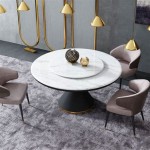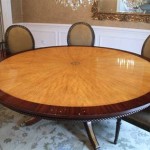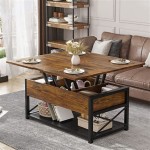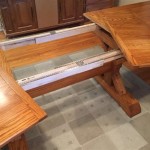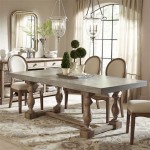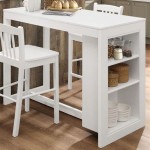Selecting the Right Wood Dining Table for 10 People
A dining table serves as a central element in any home, facilitating shared meals, family gatherings, and social events. Selecting a dining table that comfortably accommodates 10 people requires careful consideration of size, material, style, and overall functionality. This article provides a comprehensive overview of the factors involved in choosing a wood dining table for 10, ensuring both aesthetic appeal and practical utility.
When considering a wood dining table for 10 individuals, the primary consideration is size. Insufficient space can lead to discomfort and hinder conversation, while an excessively large table can overwhelm the room. A generally accepted guideline suggests allocating approximately 24 inches of table space per diner. For a table seating 10, this translates to a minimum length of 8 feet (96 inches or 244 cm). However, this is just a baseline. The width of the table must also allow adequate space for place settings, serving dishes, and decorative elements. A minimum width of 40 inches (102 cm) is recommended, and ideally, the table should be closer to 48 inches (122 cm) wide to provide ample room.
Beyond the basic dimensions, the shape of the table profoundly influences its functionality and aesthetic impact. Rectangular tables are the most common choice due to their versatility and efficient use of elongated spaces. An oval table offers a similar seating capacity as a rectangular table but softens the room with its rounded edges. Round tables, while visually appealing, require a larger square footage to accommodate the same number of diners comfortably. Square tables, while sometimes chosen for smaller groups, are less practical for seating 10 unless the room is equally square and of considerable size. A table with leaves or extension mechanisms offers flexibility, allowing the table to be reduced in size for smaller gatherings and expanded as needed. This adaptability makes it an excellent choice for those who occasionally host larger groups but typically have fewer people at the table.
The material used in the construction of the dining table significantly impacts its durability, aesthetics, and maintenance requirements. Wood, being a natural material, offers a wide range of options with distinct characteristics. Hardwoods such as oak, maple, cherry, and walnut are popular choices due to their strength, resistance to wear and tear, and beautiful grain patterns. Softwoods, like pine, are more affordable but are more susceptible to scratches and dents. The choice of wood should align with the homeowner’s lifestyle and aesthetic preferences. For example, a household with young children might prefer a more durable hardwood, whereas someone prioritizing aesthetics might opt for a specific grain pattern or color.
The finish applied to the wood also plays a crucial role. Finishes protect the wood from moisture, stains, and scratches while enhancing its natural beauty. Common finishes include varnish, lacquer, oil-based finishes, and polyurethane. Varnish and lacquer provide a durable, glossy surface, while oil-based finishes offer a more natural, matte appearance. Polyurethane is a popular choice for its resistance to water damage and scratches. The choice of finish should complement the wood type and desired aesthetic. It is also essential to consider the ease of maintenance. Some finishes require more frequent polishing or waxing to maintain their appearance.
Key Point 1: Size and Shape Considerations for Optimal Seating
The size and shape of the dining table are paramount in ensuring comfortable seating for 10 people. As previously discussed, a rectangular table is generally the most practical choice, requiring a minimum length of 96 inches and a width of 40 inches, but ideally closer to 48 inches. An oval table offers a similar seating arrangement with softer, more rounded edges, while a round table demands significantly more floor space to accommodate the same number of guests.
When measuring the dining space, allow at least 36 inches of clearance between the table and any walls or furniture to permit comfortable movement around the table. This clearance is particularly important to prevent bottlenecks and ensure that guests can easily get in and out of their seats. For tables with leaves or extensions, consider the dimensions of the fully extended table to ensure that the space will accommodate the larger size. It’s also important to visualize the table within the space. Using painter's tape to mark out the dimensions on the floor can help in visualizing the table's footprint and ensuring that it fits comfortably within the room.
The height of the table is another crucial factor. Standard dining tables typically range from 28 to 30 inches in height. This height is generally compatible with standard dining chairs. However, it is always advisable to measure the height of the chairs and ensure that there is sufficient legroom under the table. A clearance of at least 12 inches between the seat and the table apron is recommended. If using chairs with armrests, ensure they can slide comfortably under the table.
Beyond the dimensions, the shape of the table can also influence the atmosphere of the dining area. A rectangular table lends itself to more formal settings, while an oval table can create a more inviting and conversational atmosphere. The choice of shape should align with the overall aesthetic and functional needs of the dining space. Consider the flow of traffic within the room and how the table will impact the movement of people. A round or oval table might be preferable in a room with limited space as it allows for easier navigation around the table.
Key Point 2: Selecting the Right Wood and Finish for Durability and Aesthetics
The choice of wood and finish fundamentally affects the durability, aesthetics, and maintenance of the dining table. Hardwoods like oak, maple, cherry, and walnut are renowned for their strength and resistance to wear, making them ideal for high-use dining tables. Oak, known for its distinctive grain pattern and durability, is a popular choice for both traditional and contemporary settings. Maple, with its smooth, fine grain, offers a more subtle aesthetic and is well-suited for painted or stained finishes. Cherry, prized for its rich, reddish-brown hue, develops a beautiful patina over time. Walnut, a luxurious hardwood, offers a deep, dark color and a unique grain pattern.
Softwoods, such as pine, are more affordable but also softer and more prone to scratches and dents. Pine can still be a viable option, especially for rustic or farmhouse-style dining tables, where imperfections can add to the character. However, it is essential to be aware of its limitations in terms of durability. If considering a softwood, a protective finish is even more crucial to enhance its resistance to wear. Reclaimed wood, often sourced from old buildings or structures, offers a unique and eco-friendly option. Reclaimed wood typically has aged characteristics and imperfections that add to its charm. However, it is essential to ensure that the wood has been properly treated and is free from pests or harmful substances.
The finish applied to the wood protects it from moisture, stains, and scratches while enhancing its natural beauty. Varnish and lacquer provide a durable, high-gloss finish, while oil-based finishes offer a more natural, matte appearance. Polyurethane is a popular choice for its excellent resistance to water damage and scratches. The choice of finish should complement the wood type and desired aesthetic. It is also essential to consider the ease of maintenance. Some finishes require more frequent polishing or waxing to maintain their appearance.
Beyond the aesthetic considerations, the finish should also be chosen based on the table's intended use. For a table that will be subjected to frequent spills and heavy use, a durable, water-resistant finish is essential. For a table used primarily for decorative purposes, a more delicate finish might be appropriate. Consider the type of cleaning products that will be used on the table and ensure that they are compatible with the finish. Always test cleaning products on an inconspicuous area of the table before applying them to the entire surface.
Key Point 3: Style and Design Considerations for a Cohesive Dining Space
The style and design of the wood dining table should complement the overall aesthetic of the dining space and the home. Dining tables are available in a wide range of styles, from traditional to contemporary, rustic to modern. Choosing a table that aligns with the existing décor creates a cohesive and harmonious look. A traditional dining table often features ornate details, such as carved legs and a decorative apron. These tables are typically made from hardwoods like cherry or mahogany and finished with a high-gloss varnish.
Contemporary dining tables tend to have clean lines and minimalist designs. They are often made from hardwoods like oak or maple and finished with a matte or satin finish. Modern dining tables may incorporate other materials, such as metal or glass, to create a sleek and contemporary look. Rustic dining tables emphasize the natural beauty of the wood. They often feature imperfections, such as knots and grain variations, and are finished with a distressed or weathered look. Farmhouse-style dining tables are similar to rustic tables but tend to have a more refined and polished appearance.
The base of the dining table also contributes to its overall style. Pedestal bases offer a more elegant and streamlined look, while trestle bases provide a more rustic and sturdy appearance. Leg styles can range from simple, straight legs to more ornate, tapered legs. The choice of base should complement the tabletop and the overall style of the dining space.
Consider the dining chairs that will be used with the table. The chairs should complement the style and color of the table and provide comfortable seating for guests. Upholstered chairs can add a touch of elegance and comfort, while wooden chairs offer a more classic and timeless look. The height of the chairs should be compatible with the height of the table to ensure comfortable dining. It is also important to consider the overall proportion of the chairs in relation to the table. Oversized chairs can overwhelm a smaller table, while undersized chairs can look out of place with a larger table.
Furthermore, consider the lighting in the dining space. A well-placed chandelier or pendant light can enhance the ambiance of the room and highlight the dining table. The lighting should be bright enough to provide adequate illumination for dining but not so harsh that it creates glare. Dimmable lights offer flexibility, allowing the lighting to be adjusted to suit different occasions.
Ultimately, selecting the right wood dining table for 10 involves a thorough consideration of size, shape, material, finish, style, and overall functionality. By carefully evaluating these factors, homeowners can choose a table that not only meets their practical needs but also enhances the beauty and ambiance of their dining space.

Luxury 10 Seater Royal Dining Table Set Wooden Bazar

Concrete 10 Seater Dining Table With Bench

Concrete 10 Seater Dining Table With Bench

Rectangular Wooden 10 Seater Dining Table Set At 115000 Piece In Saharanpur Id 2851929876433

84 02 102 01 Dining Table For 6 8 10 Person Singapore U

Japandi Wood Table For 10 Extendable

10 Seater Live Edge Dining Table Please Check Stock Avail Insimbi Designs

Nova 10 Seater Wooden Top Dining Set Home Centre Uae

Dark Mango Wood Lloyd 6 To 10 Seater Extendable Dining Table From The Next Uk

Rectangular Wooden Royal Antique Dining Set 10 Seater At Best In Saharanpur

